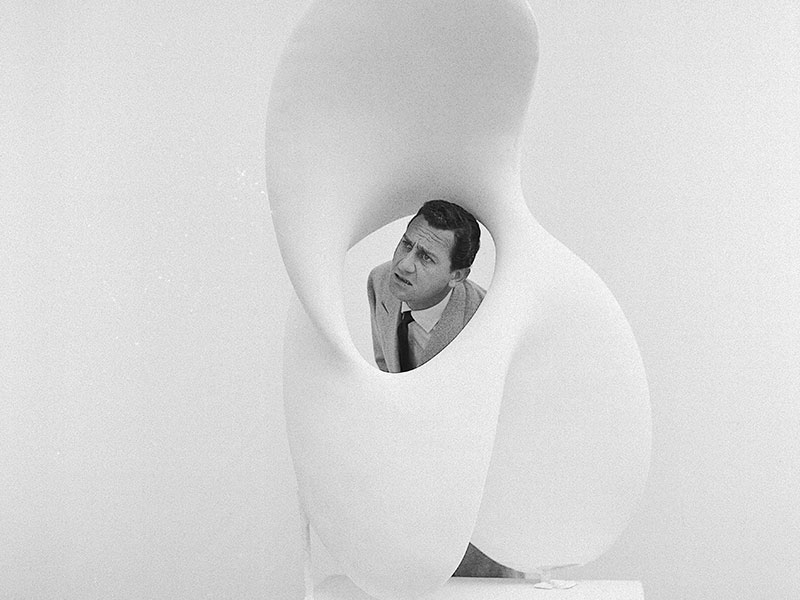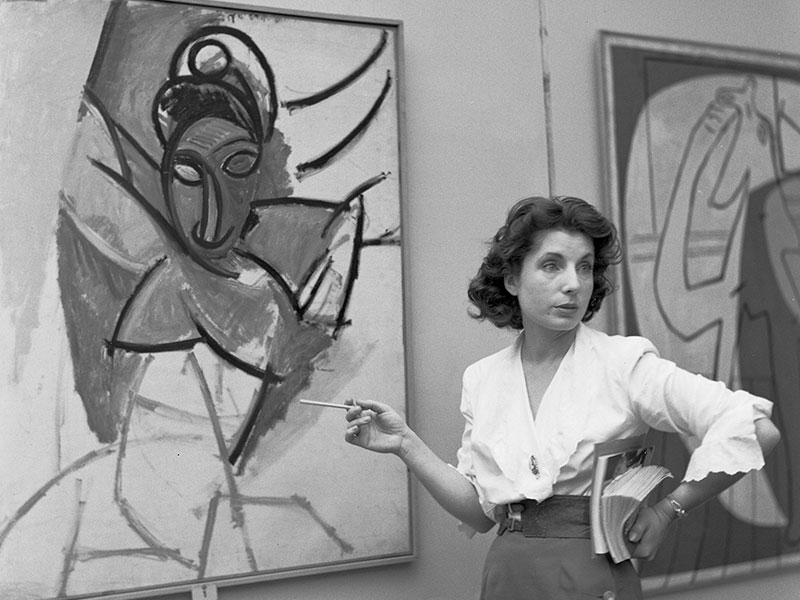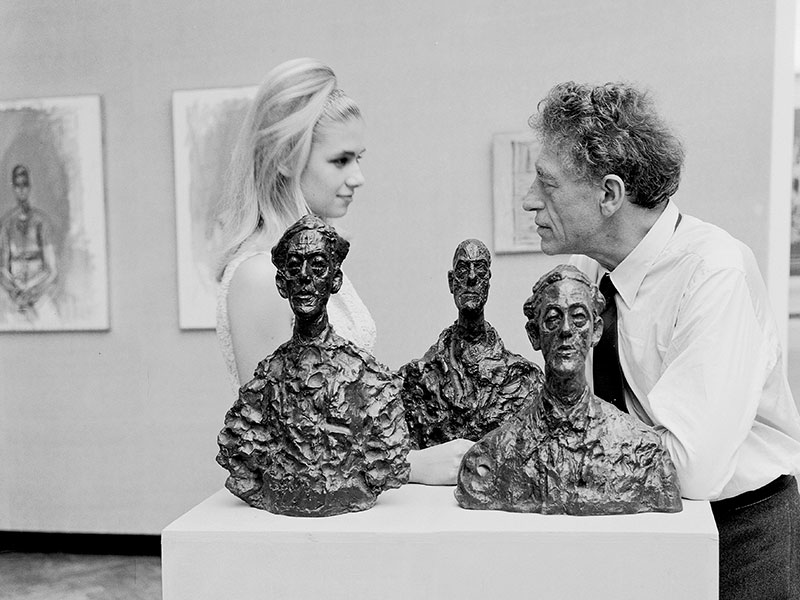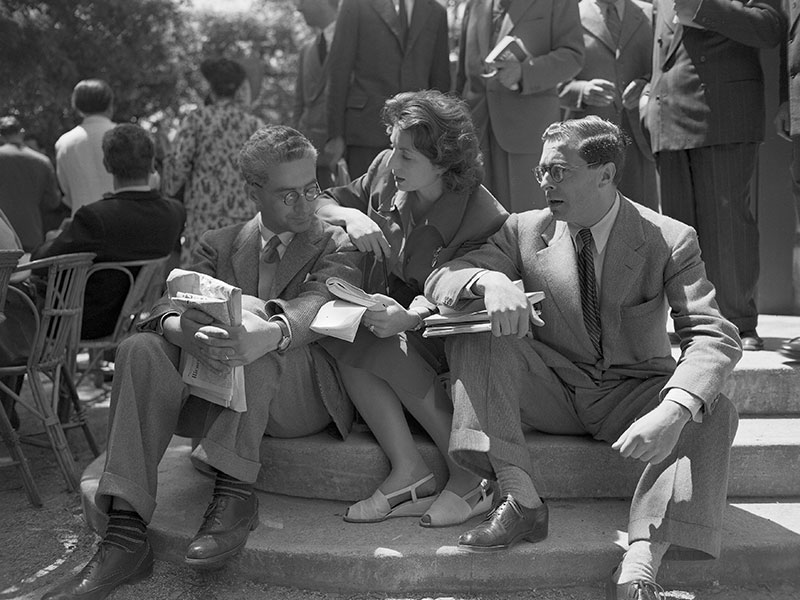VACANZE INTELLIGENTI
Art and artists in the Biennale di Venezia's pictures from the Fondazione Cassa di Risparmio di Modena
Photo exhibition
curated by Antonella Greco
in collaboration with Vittorio Sgarbi
Promoters: Assessorato alla Cultura del Comune di Milano, Milano Doc Festival, Fondazione Cassa di Risparmio di Modena con la collaborazione del Fotomuseo Giuseppe Panini di Modena
2007 September 6th - 2008 January 11th
Museo Nazionale della Scienza e della Tecnologia "Leonardo da Vinci". Milano
 In 2004 the Fondazione Cassa di Risparmio di Modena acquired more than ten thousand negatives from a Venetian photographic agency, Cameraphoto, that worked from the end of the 1940’s to the second half of the 1980’s, and was correspondent of prestigious magazines such as Life, Time and Epoca. The images that were bought by the Fondazione, snapped during the editions of the Biennial of Venice that took place between 1948 and 1986, evoke a central epoch for contemporary art and depict the protagonists of the international artistic scene: amongst others, Giacometti, Picasso, Miro, Ernst, Richier, de Chirico, Braque, Dalì, Chagall, all the way to contemporaries: Pascali, Kounellis, De Dominicis, Beuys. In a little less than two years from an initial exhibit housed at the Peggy Guggenheim Collection of Venice, the extraordinary images belonging to the Fondazione are once again on center stage, thanks to a new expositive project promoted within the Milano Doc Festival event. Set up between two venues, in Milan and Rome, this second event is characterized by the original critical slant that favors the portraits of Italian artists and for its selection of a nucleus of unpublished photographs, never before displayed in public.
In 2004 the Fondazione Cassa di Risparmio di Modena acquired more than ten thousand negatives from a Venetian photographic agency, Cameraphoto, that worked from the end of the 1940’s to the second half of the 1980’s, and was correspondent of prestigious magazines such as Life, Time and Epoca. The images that were bought by the Fondazione, snapped during the editions of the Biennial of Venice that took place between 1948 and 1986, evoke a central epoch for contemporary art and depict the protagonists of the international artistic scene: amongst others, Giacometti, Picasso, Miro, Ernst, Richier, de Chirico, Braque, Dalì, Chagall, all the way to contemporaries: Pascali, Kounellis, De Dominicis, Beuys. In a little less than two years from an initial exhibit housed at the Peggy Guggenheim Collection of Venice, the extraordinary images belonging to the Fondazione are once again on center stage, thanks to a new expositive project promoted within the Milano Doc Festival event. Set up between two venues, in Milan and Rome, this second event is characterized by the original critical slant that favors the portraits of Italian artists and for its selection of a nucleus of unpublished photographs, never before displayed in public.
Andrea Landi
President of the Fondazione Cassa di Risparmio di Modena
 In Rome, it was the period of Irene Brin (Maria Rossi, for friends) and Gaspero del Corso. The snootiest couple around: she was a commentator on lifestyle and in the thirties was on the editorial staff of “Omnibus”, he instead was, starting from 1946, the director of the most up-to-date Gallery of the capital, the Obelisco, on via Sistina where the most famous, or would-be-famous artists of the ‘50’s would go, including Burri and Rauschenberg. It was also a triumphal period for Palma Bucarelli, who had saved the works she had been entrusted with from the ravages of the war, keeping them in Caprarola, along with keeping an exhilarating diary of her endless lovers that she would, alas, only publish after she turned 80 and the protagonists were all dead. She asked that the Galleria Nazionale of Valle Giulia be liberated from the obscene war gardens and its rooms from the hundreds of crates containing relics of the fascist Revolution Exhibition. Who did she ask? Another legendary character of the post-war years; Giulio Carlo Argan, who from the administration of the Fine Arts, section V, replied, in contrast to how he would have responded in real life, with a distant and bureaucratic tone. In Rome, someone who was teaching then was Lionello Venturi, mentor of collector Riccardo Gualino who at that time was also there as owner of Lux film, plus generations of students, even the bohemians of Forma 1, such as Achille Perilli. Meanwhile the French had reappeared, in reproductions, at the Galleria Nazionale d’Arte Moderna, and soon Picasso was to arrive. However, we’re already talking about the beginning of the new decade, when a great exhibition on abstractionism was in the works. Abstractionists and representational artists in the mean time were battling it out. This was also due to an antifascist misunderstanding, as witnessed in the fight between the youth of Forma 1 and Cagli, in front of the Galleria La Palma. This one carried out, in fact, by one of the most brilliant minds of the 20-year period, Pietro Maria Bardi who would very early on leave Italy to found in Sao Paulo in Brazil, the renowned museum of modern art ( with funds coming from millionaire Assis Chateubriand, and architecture by Lina Bo, his wife ). Balla and futurism were rediscovered, on exhibit at the “Origine” gallery. Burri meanwhile, “warrior of impossible battles” in the large room of the Salaria, as Leonardo Sinisgalli writes, “sews, burns” the famous bags that, for the time being, provoked only scandals and parliamentary investigations. At Villa Massimo from 1948 there was a colony of artists, Leoncillo, a neo-cubist who used bright colors ( some had spread the rumor that he was color-blind ), Greco, who fell back on an inexhaustible technique and inexhaustible desire for beauty, Mazzacurati who had a venomous tongue, Rossi, Brunori and Guttuso. The latter who was the mouthpiece at that time of the politics of the largest leftist party, for a long time would be prevented from being truly free in his art due to this involvement, through the harsh words of Alicata and Trombadori. Guttuso had against him the libertarian and anarchical colony that came into being inside his own studio of via Margutta 5, ( Guttuso would later say: “I raised a viper in my bosom” ). Those against him were Pietro Consagra who was always at his studio, the critic Emilio Villa who occupied the premises only occasionally and Rodolfo Sonego who often visited, in misery and was still uncertain between writing and the fatal attraction he felt towards cinema. All of them speaking against Guttuso, the party and the countesses ( discreet attention was given to Guttuso’s wife, Mimise Bezzi Scala ), militarily occupied the Osteria Menghi and embellished the walls, as Ugo Pirro would recount much later, between extreme passions and extreme betrayals fomented by the excitement of the end of the war and hunger. These young people were presided over by Mafai, who was still undecided between neo-cubism and the “ropes”, with Turcato and Consagra, Dorazio and all the others, amongst whom was Scarpitta, the crazy American who made cars to be exhibited in the gallery. Not all, but many of these characters, after having borrowed money, having spent nights wide awake on crowded trains, found themselves in ’48 in Venice, for the Biennial that was reopening: Leoncillo was there, very skinny with hypnotic eyes, Carrà too was there, old and toothless, Severini showed up along with the very young Romana. Carlo Levi was there, taking flight, with his incredible velvet ties; one can read, to believe this tale, a marvelous portrait written by Montanelli. But, above all there’s Palma. Algid and very elegant, the only woman in a world, that of critics, that seemed to be destined for males. White and ethereal, but comradely seated on the steps of the biennial between Rodolfo Pallucchini and one of the saviors of the country, a definition that responds to the serious face and the magnificent intelligence of Carlo Ludovico Ragghianti. Palma too, escorted by faithful Monelli, is masterfully depicted by the perfidious Montanelli. While in a Venetian restaurant she asks with distant demeanor for impossible things like in a Lubitsch film: champagne rice and other model trifles ( “you don’t have it? Bring me a melon with Port” ). These and other small portraits, like the one of Venturi at the head of the table between Guttuso and Mimise wearing a hat or Gio Ponti with Lisa, Bucarelli dressed in white, inaugurating the Biennial of 1950, the only woman, totally surrounded by dozens of Christian Democrat politicians dressed in black or grey, Manzù with his dog, Severini with Levi and so forth, are not just part of our recollections, instead they belong to an extraordinary Venetian photographic archive, that has recently been acquired by the Fondazione Cassa di Risparmio di Modena, and is still partially unpublished. They are made up of beautiful photographs that cover the modern culture of our country on the stage of the Biennials from ’48 to ’86. Even if one hundred of the more glamorous photographs, the ones with the models, those with international artists and those of the Biennials of the ‘70’s, have already been shown in a beautiful exhibition at the Fondazione Guggenheim of Venice not too long ago, there still remains a wealth of unpublished photographs. These photographs regard Italian artists, the first Biennials following the war and the visits of architects Le Corbusier and Louis Kahn who were asked by the IUAV ( University of Venice ) to create unforgettable works ( Le Corbusier, the hospital, Kahn, the Italian Convention Pavilion ). They were both, however, ultimately disappointed in their expectations, just as had happened previously to prophet Frank Lloyd Wright for the Masieri Memorial project. It would have seemed almost impossible after the Venetian exhibition, to dig further into the archives and find unforgettable shots, yet we have de Chirico with Isabella Far, de Pisis in a striped bathrobe standing between his paintings, Marino leaning against one of his horses and Burri trying to enchant an American collector. There’s also Fontana dressed up in his tight-fitting tailor-made suit ( according to his friends, it was one of his vices ), looking perplexed at the holes that puncture his spatial concepts, the pop art of 1964 being observed doubtfully by beautiful Mambor and a Pitagora in love, 1968 is captured with the young people in the squares ( Francesco Dal Co is totally recognizable, young Cacciari instead is indistinguishable )… All the way up to the Biennials of the ‘70’s, following the ironic smile of Gino de Dominicis who leans over a young Gulliver, Pinocchio’s skeleton with a pair of roller skates ( he had moreover, done it big: hanging up high in a room a thirty year old man with Down syndrome, solely to make sure he did not avoid controversy.. ); the move was inspired by Julian Beck; the butterflies in the square, the mechanical bulls… It isn’t a tale, it couldn’t be: it’s a history of stories, of artists, of critics, of movements and of cities. Soon Alberto Sordi would appear and soon they would exchange his chubby consort for an installation or a living sculpture à la Gilbert & George. For the time being though, these bright blacks and whites that will never come to be again, enchant us. Never again will Dalì dance with Ludmilla Tchérina, never again will a peasant woman with a kerchief on her head stop perplexed to look at a rooster coming out of Rauschenberg’s combine paintings. Never again. If not in this exhibit.
In Rome, it was the period of Irene Brin (Maria Rossi, for friends) and Gaspero del Corso. The snootiest couple around: she was a commentator on lifestyle and in the thirties was on the editorial staff of “Omnibus”, he instead was, starting from 1946, the director of the most up-to-date Gallery of the capital, the Obelisco, on via Sistina where the most famous, or would-be-famous artists of the ‘50’s would go, including Burri and Rauschenberg. It was also a triumphal period for Palma Bucarelli, who had saved the works she had been entrusted with from the ravages of the war, keeping them in Caprarola, along with keeping an exhilarating diary of her endless lovers that she would, alas, only publish after she turned 80 and the protagonists were all dead. She asked that the Galleria Nazionale of Valle Giulia be liberated from the obscene war gardens and its rooms from the hundreds of crates containing relics of the fascist Revolution Exhibition. Who did she ask? Another legendary character of the post-war years; Giulio Carlo Argan, who from the administration of the Fine Arts, section V, replied, in contrast to how he would have responded in real life, with a distant and bureaucratic tone. In Rome, someone who was teaching then was Lionello Venturi, mentor of collector Riccardo Gualino who at that time was also there as owner of Lux film, plus generations of students, even the bohemians of Forma 1, such as Achille Perilli. Meanwhile the French had reappeared, in reproductions, at the Galleria Nazionale d’Arte Moderna, and soon Picasso was to arrive. However, we’re already talking about the beginning of the new decade, when a great exhibition on abstractionism was in the works. Abstractionists and representational artists in the mean time were battling it out. This was also due to an antifascist misunderstanding, as witnessed in the fight between the youth of Forma 1 and Cagli, in front of the Galleria La Palma. This one carried out, in fact, by one of the most brilliant minds of the 20-year period, Pietro Maria Bardi who would very early on leave Italy to found in Sao Paulo in Brazil, the renowned museum of modern art ( with funds coming from millionaire Assis Chateubriand, and architecture by Lina Bo, his wife ). Balla and futurism were rediscovered, on exhibit at the “Origine” gallery. Burri meanwhile, “warrior of impossible battles” in the large room of the Salaria, as Leonardo Sinisgalli writes, “sews, burns” the famous bags that, for the time being, provoked only scandals and parliamentary investigations. At Villa Massimo from 1948 there was a colony of artists, Leoncillo, a neo-cubist who used bright colors ( some had spread the rumor that he was color-blind ), Greco, who fell back on an inexhaustible technique and inexhaustible desire for beauty, Mazzacurati who had a venomous tongue, Rossi, Brunori and Guttuso. The latter who was the mouthpiece at that time of the politics of the largest leftist party, for a long time would be prevented from being truly free in his art due to this involvement, through the harsh words of Alicata and Trombadori. Guttuso had against him the libertarian and anarchical colony that came into being inside his own studio of via Margutta 5, ( Guttuso would later say: “I raised a viper in my bosom” ). Those against him were Pietro Consagra who was always at his studio, the critic Emilio Villa who occupied the premises only occasionally and Rodolfo Sonego who often visited, in misery and was still uncertain between writing and the fatal attraction he felt towards cinema. All of them speaking against Guttuso, the party and the countesses ( discreet attention was given to Guttuso’s wife, Mimise Bezzi Scala ), militarily occupied the Osteria Menghi and embellished the walls, as Ugo Pirro would recount much later, between extreme passions and extreme betrayals fomented by the excitement of the end of the war and hunger. These young people were presided over by Mafai, who was still undecided between neo-cubism and the “ropes”, with Turcato and Consagra, Dorazio and all the others, amongst whom was Scarpitta, the crazy American who made cars to be exhibited in the gallery. Not all, but many of these characters, after having borrowed money, having spent nights wide awake on crowded trains, found themselves in ’48 in Venice, for the Biennial that was reopening: Leoncillo was there, very skinny with hypnotic eyes, Carrà too was there, old and toothless, Severini showed up along with the very young Romana. Carlo Levi was there, taking flight, with his incredible velvet ties; one can read, to believe this tale, a marvelous portrait written by Montanelli. But, above all there’s Palma. Algid and very elegant, the only woman in a world, that of critics, that seemed to be destined for males. White and ethereal, but comradely seated on the steps of the biennial between Rodolfo Pallucchini and one of the saviors of the country, a definition that responds to the serious face and the magnificent intelligence of Carlo Ludovico Ragghianti. Palma too, escorted by faithful Monelli, is masterfully depicted by the perfidious Montanelli. While in a Venetian restaurant she asks with distant demeanor for impossible things like in a Lubitsch film: champagne rice and other model trifles ( “you don’t have it? Bring me a melon with Port” ). These and other small portraits, like the one of Venturi at the head of the table between Guttuso and Mimise wearing a hat or Gio Ponti with Lisa, Bucarelli dressed in white, inaugurating the Biennial of 1950, the only woman, totally surrounded by dozens of Christian Democrat politicians dressed in black or grey, Manzù with his dog, Severini with Levi and so forth, are not just part of our recollections, instead they belong to an extraordinary Venetian photographic archive, that has recently been acquired by the Fondazione Cassa di Risparmio di Modena, and is still partially unpublished. They are made up of beautiful photographs that cover the modern culture of our country on the stage of the Biennials from ’48 to ’86. Even if one hundred of the more glamorous photographs, the ones with the models, those with international artists and those of the Biennials of the ‘70’s, have already been shown in a beautiful exhibition at the Fondazione Guggenheim of Venice not too long ago, there still remains a wealth of unpublished photographs. These photographs regard Italian artists, the first Biennials following the war and the visits of architects Le Corbusier and Louis Kahn who were asked by the IUAV ( University of Venice ) to create unforgettable works ( Le Corbusier, the hospital, Kahn, the Italian Convention Pavilion ). They were both, however, ultimately disappointed in their expectations, just as had happened previously to prophet Frank Lloyd Wright for the Masieri Memorial project. It would have seemed almost impossible after the Venetian exhibition, to dig further into the archives and find unforgettable shots, yet we have de Chirico with Isabella Far, de Pisis in a striped bathrobe standing between his paintings, Marino leaning against one of his horses and Burri trying to enchant an American collector. There’s also Fontana dressed up in his tight-fitting tailor-made suit ( according to his friends, it was one of his vices ), looking perplexed at the holes that puncture his spatial concepts, the pop art of 1964 being observed doubtfully by beautiful Mambor and a Pitagora in love, 1968 is captured with the young people in the squares ( Francesco Dal Co is totally recognizable, young Cacciari instead is indistinguishable )… All the way up to the Biennials of the ‘70’s, following the ironic smile of Gino de Dominicis who leans over a young Gulliver, Pinocchio’s skeleton with a pair of roller skates ( he had moreover, done it big: hanging up high in a room a thirty year old man with Down syndrome, solely to make sure he did not avoid controversy.. ); the move was inspired by Julian Beck; the butterflies in the square, the mechanical bulls… It isn’t a tale, it couldn’t be: it’s a history of stories, of artists, of critics, of movements and of cities. Soon Alberto Sordi would appear and soon they would exchange his chubby consort for an installation or a living sculpture à la Gilbert & George. For the time being though, these bright blacks and whites that will never come to be again, enchant us. Never again will Dalì dance with Ludmilla Tchérina, never again will a peasant woman with a kerchief on her head stop perplexed to look at a rooster coming out of Rauschenberg’s combine paintings. Never again. If not in this exhibit.
Antonella Greco

